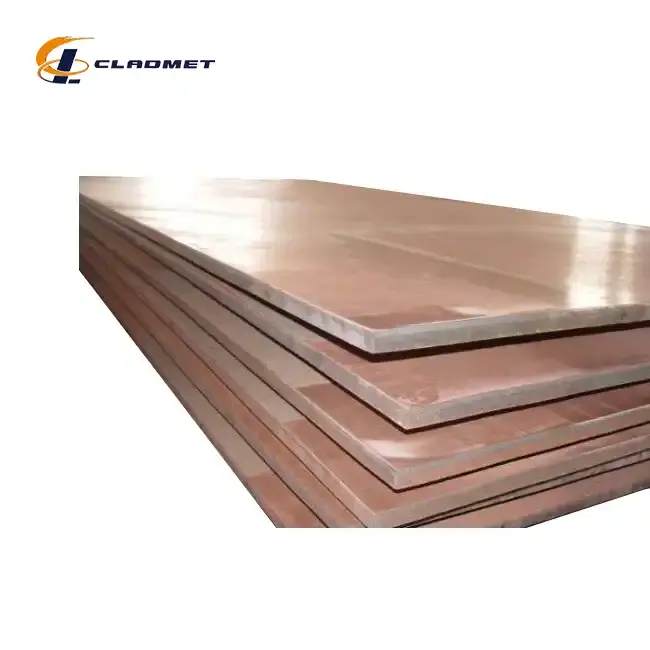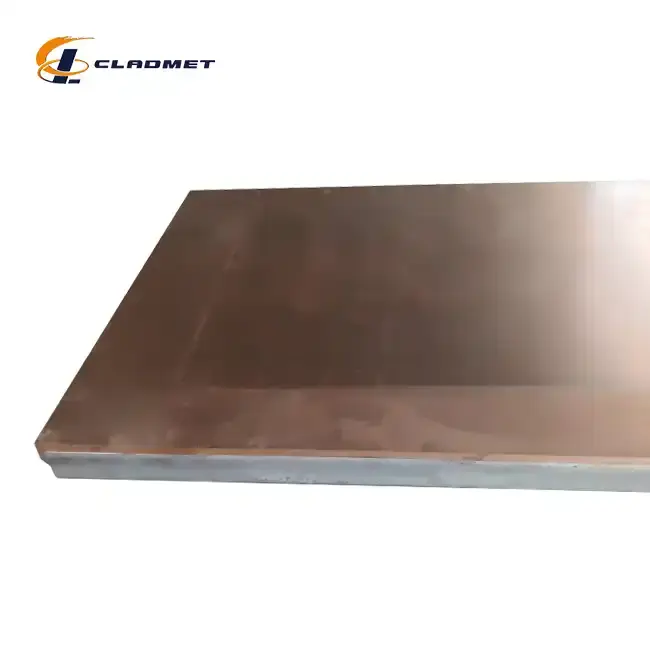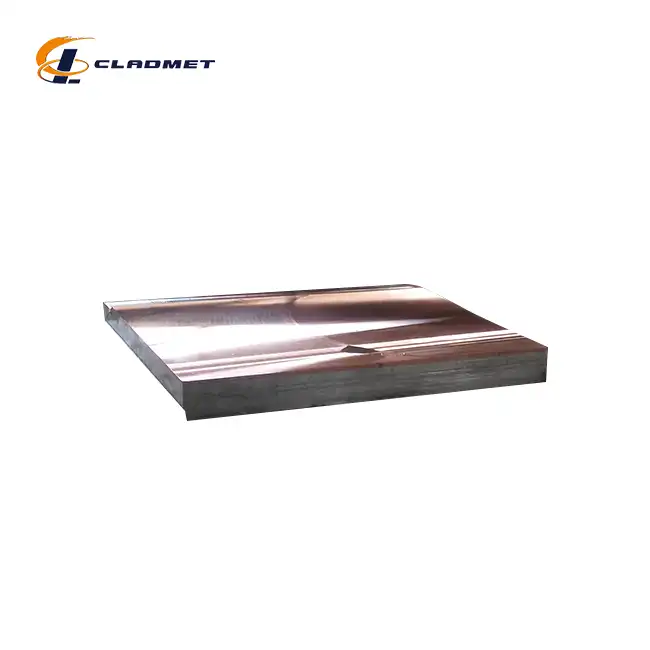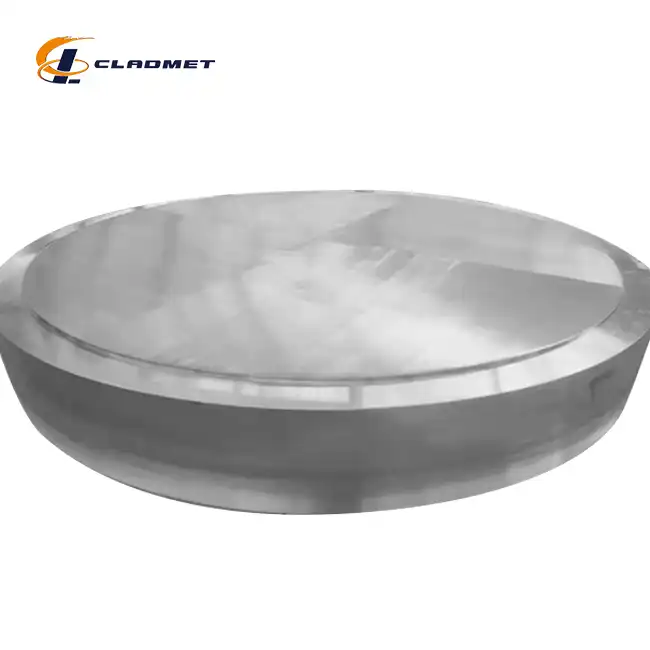How Does Explosion Bonding Enhance the Durability of Aluminum Copper Clad Plates?
 2025-07-11 09:38:23
View:389
2025-07-11 09:38:23
View:389Explosion bonding technology represents a revolutionary advancement in metallurgical engineering that dramatically enhances the durability and performance characteristics of aluminum copper clad plates through sophisticated explosive welding processes. This cutting-edge manufacturing technique utilizes controlled explosive charges to create permanent metallurgical bonds between aluminum and copper layers, resulting in composite materials that exhibit superior mechanical properties, enhanced corrosion resistance, and exceptional structural integrity. The aluminum copper clad plate produced through explosion bonding demonstrates remarkable durability under extreme operating conditions, combining the lightweight characteristics of aluminum with copper's outstanding electrical and thermal conductivity while maintaining long-term reliability in demanding industrial applications. The explosive welding process generates atomic-level bonding that surpasses conventional joining methods, creating a composite material where the interfacial strength often exceeds the strength of the individual constituent metals, making explosion-bonded aluminum copper clad plates the preferred choice for critical applications requiring exceptional durability and performance.

Explosive Welding Fundamentals and Metallurgical Bond Formation
The Physics of Controlled Explosive Impact in Aluminum Copper Bonding
The explosion bonding process for aluminum copper clad plates operates on fundamental principles of high-velocity impact metallurgy, where precisely controlled explosive charges generate collision velocities ranging from 200 to 1000 meters per second between the aluminum flyer plate and copper base material. During the explosive welding process, the detonation wave propagates across the explosive layer at velocities exceeding 2000 meters per second, creating a progressive collision zone that moves along the interface between the two metals. The aluminum copper clad plate formation requires careful calculation of explosive loading parameters, including standoff distance, explosive thickness, and detonation velocity, to ensure optimal collision angles typically ranging from 5 to 30 degrees. The controlled impact generates extreme pressure conditions reaching several gigapascals and instantaneous temperatures exceeding 1000°C at the collision point, causing localized melting and rapid solidification that creates a metallurgically sound bond. Advanced explosive welding facilities utilize sophisticated monitoring systems to ensure consistent collision parameters across the entire bonding area, resulting in aluminum copper clad plates with uniform bond quality and predictable mechanical properties. The physics of explosive impact also creates characteristic jet formation at the collision point, which removes surface oxides and contaminants while simultaneously creating fresh, reactive metal surfaces that facilitate strong metallurgical bonding between aluminum and copper.
Intermetallic Phase Formation and Interface Microstructure
The explosion bonding process creates unique microstructural characteristics in aluminum copper clad plates through the formation of thin intermetallic layers and distinctive wave patterns at the bonding interface. Metallographic examination of explosion-bonded aluminum copper clad plates reveals a complex interfacial zone characterized by periodic wave formation with wavelengths typically ranging from 100 to 1000 micrometers and amplitudes of 10 to 100 micrometers. The wave pattern results from the hydrodynamic instabilities that develop during the high-velocity collision process, creating mechanical interlocking between the aluminum and copper layers that significantly enhances bond strength and durability. Electron microscopy analysis demonstrates that the bonding interface contains thin layers of intermetallic compounds, primarily Al₂Cu and AlCu phases, which form through rapid diffusion during the brief high-temperature period following impact. These intermetallic layers, when present in optimal thicknesses of less than 5 micrometers, contribute to bond strength without compromising ductility of the aluminum copper clad plate. The microstructural analysis also reveals that explosion bonding preserves the grain structure and mechanical properties of both aluminum and copper away from the interface, ensuring that the composite material maintains the desirable characteristics of each constituent metal while achieving superior overall performance through synergistic effects of the metallurgical bond.
Quality Control and Bond Integrity Assessment
Modern explosion bonding operations for aluminum copper clad plates incorporate comprehensive quality control measures that ensure consistent bond integrity and adherence to international standards including ASTM, ASME, and JIS specifications. Non-destructive testing methods, including ultrasonic inspection, radiographic examination, and magnetic particle testing, are routinely employed to verify bond continuity and detect any potential defects in the aluminum copper clad plate structure. Destructive testing protocols, such as peel tests, shear tests, and tensile tests, provide quantitative measurements of bond strength typically exceeding 200 MPa in high-quality explosion-bonded materials. Quality assurance procedures also include metallographic examination of representative samples to verify optimal microstructural characteristics and intermetallic layer thickness in the aluminum copper clad plate. Advanced quality control systems monitor explosive parameters in real-time during the bonding process, ensuring consistent collision velocities and impact angles across the entire bonding area. The implementation of statistical process control methods enables continuous improvement of explosion bonding parameters, resulting in aluminum copper clad plates with enhanced reliability and predictable performance characteristics. Quality certification processes, including ISO9001-2000 compliance and PED/ABS international qualifications, ensure that explosion-bonded aluminum copper clad plates meet the most stringent industry requirements for critical applications in aerospace, automotive, and power generation industries.
Superior Mechanical Properties and Structural Performance
Enhanced Bond Strength and Shear Resistance Characteristics
Explosion bonding produces aluminum copper clad plates with exceptional bond strength characteristics that significantly surpass conventional joining methods through the creation of metallurgical bonds with shear strengths typically ranging from 150 to 400 MPa. The superior bond strength results from the combination of metallurgical welding at the atomic level and mechanical interlocking created by the characteristic wave pattern at the aluminum-copper interface. Comparative testing demonstrates that explosion-bonded aluminum copper clad plates exhibit bond strengths 3 to 5 times higher than adhesively bonded alternatives and 2 to 3 times stronger than diffusion-bonded materials under similar test conditions. The shear resistance of aluminum copper clad plates is further enhanced by the continuous nature of the explosion-bonded interface, which distributes applied loads across the entire bonded area rather than concentrating stresses at discrete bonding points as occurs in mechanically fastened joints. Advanced mechanical testing, including fatigue testing under cyclic loading conditions, confirms that explosion-bonded aluminum copper clad plates maintain their structural integrity through millions of load cycles without significant degradation in bond strength. The exceptional bond strength enables aluminum copper clad plates to function effectively in high-stress applications such as electrical busbars carrying thousands of amperes, heat exchangers operating under high-pressure conditions, and structural components subjected to dynamic loading in transportation and aerospace applications.
Thermal Expansion Compatibility and Dimensional Stability
The explosion bonding process creates aluminum copper clad plates with superior thermal expansion compatibility through the development of a graded interface that effectively manages differential thermal stresses between the aluminum and copper layers. The metallurgical bond formed through explosive welding accommodates the different thermal expansion coefficients of aluminum (23 × 10⁻⁶/°C) and copper (17 × 10⁻⁶/°C) by distributing thermal stresses across the wavy interface structure rather than concentrating them at discrete bonding locations. Thermal cycling tests conducted on aluminum copper clad plates demonstrate exceptional dimensional stability through thousands of heating and cooling cycles between -40°C and 200°C without measurable delamination or bond degradation. The superior thermal expansion compatibility of explosion-bonded aluminum copper clad plates makes them particularly valuable in applications involving significant temperature variations, such as automotive heat exchangers, electronic cooling systems, and power distribution equipment where thermal cycling could cause failure in conventionally bonded materials. Advanced finite element analysis of thermal stress distribution in aluminum copper clad plates confirms that the wave pattern at the explosion-bonded interface acts as a stress relief mechanism, preventing the development of critical stress concentrations that could lead to crack initiation and propagation. The dimensional stability characteristics are further enhanced by the ability to customize the aluminum copper clad plate thickness ratio and surface treatments to optimize thermal performance for specific application requirements.
Impact Resistance and Dynamic Loading Performance
Explosion bonding creates aluminum copper clad plates with remarkable resistance to impact loading and dynamic stresses through the development of a tough, energy-absorbing interface that can withstand sudden mechanical shocks without delamination. The unique bonding mechanism produces a graded interface structure that dissipates impact energy through controlled plastic deformation of the wave pattern while maintaining overall structural continuity of the aluminum copper clad plate. Dynamic impact testing using drop weight and ballistic impact methods demonstrates that explosion-bonded aluminum copper clad plates can absorb impact energies exceeding 150 joules per square centimeter without bond failure, representing a significant improvement over adhesively bonded or mechanically fastened alternatives. The impact resistance characteristics are attributed to the tough, ductile nature of the metallurgical bond and the absence of stress concentrators typically found in mechanical fastening systems. Vibration testing under high-frequency loading conditions confirms that aluminum copper clad plates maintain their bond integrity and electrical conductivity even when subjected to severe vibrational environments common in transportation, mining, and industrial machinery applications. The superior dynamic loading performance enables aluminum copper clad plates to function reliably in demanding applications such as electrical contacts in railway systems, busbar connections in power substations, and heat exchanger components in heavy industrial equipment where sudden mechanical shocks and continuous vibration could compromise the performance of conventionally bonded materials.

Advanced Corrosion Resistance and Environmental Performance
Galvanic Corrosion Prevention and Electrochemical Stability
The explosion bonding process creates aluminum copper clad plates with enhanced resistance to galvanic corrosion through the formation of a continuous metallurgical barrier that prevents the establishment of electrochemical cells between the dissimilar metals while maintaining optimal electrical conductivity. The strong metallurgical bond eliminates the crevices, gaps, and discontinuities that typically exist in mechanically fastened or adhesively bonded joints, where moisture and corrosive electrolytes can accumulate and initiate localized corrosion processes. Electrochemical testing of aluminum copper clad plates in various corrosive environments demonstrates that the explosion-bonded interface maintains its integrity even when exposed to saltwater, industrial atmospheres, and chemical processing environments that would cause rapid degradation of conventional bonding methods. The galvanic compatibility of aluminum copper clad plates is further enhanced by the ability to apply protective coatings or surface treatments to the exposed aluminum surface while maintaining the copper's conductivity for electrical applications. Advanced corrosion testing protocols, including salt spray testing according to ASTM B117 standards and cyclic corrosion testing, confirm that explosion-bonded aluminum copper clad plates exhibit corrosion rates comparable to or better than monolithic copper while providing the weight reduction benefits of aluminum construction. The electrochemical stability characteristics make aluminum copper clad plates particularly suitable for marine applications, offshore electrical systems, and chemical processing equipment where long-term corrosion resistance is critical for operational reliability and safety.
Chemical Compatibility and Process Environment Resistance
Explosion bonding produces aluminum copper clad plates with exceptional chemical compatibility across a wide range of industrial process environments, including exposure to acids, bases, organic solvents, and aggressive chemical media that could compromise conventional bonding systems. The metallurgical bond created through explosive welding provides a continuous barrier to chemical penetration that prevents degradation of the bonding interface even when exposed to corrosive chemicals that might dissolve organic adhesives or attack mechanical fasteners. Chemical compatibility testing reveals that aluminum copper clad plates maintain their structural integrity and electrical properties when exposed to sulfuric acid concentrations up to 50%, sodium hydroxide solutions up to 20%, and various organic solvents commonly encountered in chemical processing operations. The chemical resistance of aluminum copper clad plates is further enhanced by the inherent corrosion resistance of both constituent metals, with aluminum forming a protective oxide layer and copper developing stable patina that provides long-term protection against environmental degradation. Advanced accelerated testing protocols demonstrate that explosion-bonded aluminum copper clad plates retain their bond strength and dimensional stability after extended exposure to elevated temperatures up to 200°C in chemically aggressive environments. The superior chemical compatibility makes aluminum copper clad plates ideal for applications in petrochemical processing, pharmaceutical manufacturing, and environmental protection systems where material reliability in harsh chemical environments is essential for process safety and equipment longevity.
Long-term Environmental Durability and Weathering Performance
The explosion bonding process creates aluminum copper clad plates with exceptional long-term environmental durability, demonstrated through comprehensive weathering studies and accelerated aging tests that confirm the stability of the metallurgical bond under various climatic conditions and atmospheric exposures. Extended outdoor exposure testing programs spanning multiple decades have documented the consistent performance of aluminum copper clad plates in diverse geographic locations, including coastal marine environments, urban industrial atmospheres, and rural agricultural settings with minimal degradation in mechanical properties or electrical conductivity. The environmental durability of aluminum copper clad plates is attributed to the stable nature of the explosion-bonded interface, which does not rely on organic materials or mechanical hardware that can deteriorate over time due to ultraviolet radiation, temperature cycling, or atmospheric pollutants. Accelerated weathering tests using xenon arc exposure and QUV testing protocols demonstrate that aluminum copper clad plates maintain their bond integrity and surface appearance after exposure equivalent to 25 years of outdoor service in harsh environments. The weathering resistance is further enhanced by the ability to specify custom surface treatments, including anodizing of the aluminum surface and protective coatings for the copper layer, to optimize environmental performance for specific installation conditions. Field performance data from aluminum copper clad plates installed in electrical transmission systems, architectural applications, and industrial facilities confirm service lives exceeding 30 years with minimal maintenance requirements, making them an economical choice for long-term infrastructure investments where reliability and durability are paramount considerations.
Conclusion
Explosion bonding technology represents a paradigm shift in manufacturing aluminum copper clad plates, delivering unprecedented durability through metallurgical bonds that surpass conventional joining methods in strength, corrosion resistance, and long-term reliability. The controlled explosive welding process creates atomic-level bonding with characteristic wave patterns that provide exceptional mechanical interlocking and thermal stress accommodation. The resulting aluminum copper clad plates demonstrate superior performance across demanding industrial applications while combining the beneficial properties of both constituent metals through innovative manufacturing excellence.
Partner with Baoji JL Clad Metals Materials Co., Ltd. to experience the transformative power of our advanced explosion bonding technology and unlock superior performance for your critical applications. With over two decades of metallurgical expertise, independent explosive composite technology, and comprehensive international certifications including ISO9001-2000, PED, and ABS qualifications, we deliver customized aluminum copper clad plate solutions that exceed industry standards. Our innovative R&D capabilities, cutting-edge manufacturing processes, and comprehensive OEM/ODM services ensure precision-engineered products tailored to your exact specifications. Whether you require standard configurations or custom dimensions up to 2500mm width with thicknesses from 0.5mm to 20mm, our global manufacturing and distribution network provides reliable supply chain solutions. Transform your projects with our technologically superior aluminum copper clad plates that combine durability, performance, and value. Contact our technical specialists today at sales@cladmet.com to discuss your specific requirements and discover how our explosive welding expertise can enhance your product performance and competitive advantage.
References
1. Crossland, B., & Williams, J.D. (1970). Explosive welding of metals and its application. Oxford: Pergamon Press.
2. Hokamoto, K., Vesenjak, M., Ren, Z., & Tanaka, S. (2013). Explosive welding of aluminum-copper plates and its interface microstructure. Journal of Materials Processing Technology, 213(8), 1395-1401.
3. Paul, H., Morgiel, J., Faryna, M., & Lityñska-Dobrzyñska, L. (2018). Microstructural characterization of interfacial regions in explosively welded aluminum-copper bimetallic plates. Materials Characterization, 145, 671-683.
4. Zhang, L.J., Pei, Q., Zhang, J.X., & Li, P.C. (2014). Study on explosive welding of aluminum-copper plates: Interface morphology and mechanical properties. Materials & Design, 63, 213-221.

_1737007724117.webp)
_1736996330512.webp)









